Comparisons of the Effects of Polymer and Alcohol Varnishes on Norway Spruce Wood Surface Modifications
Abstract
1. Introduction
2. Materials and Methods
2.1. Sample Preparation
| Layers | Spirit Varnish (LS) | Nitrocellulose Varnish (NC) | Oil-Based Varnish (LU) |
|---|---|---|---|
| 1 | KD | WS-125 yellow | WS-R |
| 2 | LS+CEV2901 | WS-104 nut brown | LU |
| 3 | LS+CEV2901 | NC base coat | LU+CEV2901 |
| 4 | LS+CEV2903 | NC | LU+CEV2901 |
| 5 | LS+CEV2901+CEV2903 | NC | LU+CEV2903 |
| 6 | LS+CEV2901+CEV2903 | NC | LU+CEV2903 |
| 7 | LS+CEV2901+CEV2903 | NC | LU+CEV2904 |
| 8 | LS+CEV2904 | NC | LU+CEV2904 |
| 9 | LS+CEV2904 | NC | LU+CEV2904 |
| 10 | LS+CEV2904 | NC | LU+CEV2904 |
| 11 | LS | NC | LU+CEV2904 |
| 12 | LS | NC | LU+CEV2904 |
| 13 | LS | NC | LU |
| 14 | LS | NC | LU |
| 15 | LS | NC | LU |

2.2. Methods
2.2.1. Thickness of Varnishes’ Film
2.2.2. Color Measurement
2.2.3. The Contact Angle Method
2.2.4. Fourier Transformed Infrared (FTIR) Spectroscopy
2.2.5. Statistical Analysis
3. Results and Discussion
3.1. Variation in Areal Mass Loading
3.2. Variation in Color Parameters
3.2.1. Changes in Color Parameters During the Varnishing Process
3.2.2. Changes in Color Parameters in Accordance with the Thickness of Varnish
3.3. Surface Morphology of Varnished Wood Samples
3.4. Correlation Between Color and Surface Parameters Based on Statistical Analysis
3.5. FTIR Spectroscopy
4. Conclusions
- The color parameters depend on the type of varnish and the thickness of the varnish film; the largest changes in redness and yellowness are recorded when applying the five layers containing the coloring pigments.
- The fastest stabilization of color parameters was observed with nitrocellulose varnish.
- Spruce wood with wide annual rings and a higher proportion of early wood (quality class D) has 25% higher surface energy compared to spruce wood with narrow annual rings (class A).
- The varnish film modifies the surface energy of the wood, reducing it by approximately 50% compared to unvarnished wood, the lowest values being recorded for oil-based varnish.
- Polar and dispersive energy depend on the varnish solvent and the number of layers applied.
- The varnish film modifies the FTIR absorption bands, completely covering the wood, leading to the formation of a new layered material consisting of the wood–varnish interface and the varnish film.
Author Contributions
Funding
Institutional Review Board Statement
Data Availability Statement
Acknowledgments
Conflicts of Interest
References
- Španić, N.; Jambreković, V.; Klarić, M. Basic chemical composition of wood as a parameter in raw material selection for biocomposite production. Cellul. Chem. Technol. 2018, 52, 163–169. [Google Scholar]
- Srndovic, A.S. Interactions between Wood Polymers in Wood Cell Walls and Cellulose/Hemicellulose Biocomposites. Ph.D. Thesis, Chalmers University of Technology, Gothenburg, Sweden, 2011. [Google Scholar]
- Gh, P.; Popa, V.I. Chimia și Prelucrarea Chimică a Lemnului; Publisher Lux Libris: Brasov, Romania, 1997; Volume II. (In Romanian) [Google Scholar]
- Stanciu, M.D.; Teodorescu, H.D.; Vlase, S.; Mihalcica, M.; Cosnită, M.; Savin, A. Multiscale assessment of artificial aging treatment of polysaccharides from tonewood species. Int. J. Biol. Macromol. 2024, 274, 133310. [Google Scholar] [CrossRef] [PubMed]
- Sahin, H.T. Wood-Water Interactions as Affected by Chemical Constituents of Woods. Asian J. Chem. 2008, 20, 3267–3276. [Google Scholar]
- Zhou, J.; Wang, X.; He, L.; Wan, K.; Guo, Y.; Zhang, J.; Miao, Y.; Liu, Z. The Changes of Acoustic Vibration Properties of Spruce Wood During the Multi-Layered Alcohol Varnish Coating Process. Forests 2024, 15, 2212. [Google Scholar] [CrossRef]
- Echard, J.-P.; Lavédrine, B. Review on the characterisation of ancient stringed musical instruments varnishes and implementation of an analytical strategy. J. Cult. Herit. 2008, 9, 420–429. [Google Scholar] [CrossRef]
- Caruso, F.; Chillura Martino, D.F.; Saverwyns, S.; Van Bos, M.; Burgio, L.; Di Stefano, C.; Peschke, G.; Caponetti, E. Micro-analytical identification of the components of varnishes from South Italian historical musical instruments by PLM, ESEM–EDX microFTIR, GC–MS, and Py–GC–MS. Microchem. J. 2014, 116, 31–40. [Google Scholar] [CrossRef]
- Weththimuni, M.L.; Canevari, C.; Legnani, A.; Licchelli, M.; Malagodi, M.; Ricca, M.; Zeffiro, A. Experimental characterization of oil-colophony varnishes: A preliminary study. Int. J. Conserv. Sci. 2016, 7, 813–826. [Google Scholar]
- Odlyha, M.; Lucejko, J.J.; Lluveras-Tenorio, A.; di Girolamo, F.; Hudziak, S.; Strange, A.; Bridarolli, A.; Bozec, L.; Colombini, M.P. Violin Varnishes: Microstructure and Nanomechanical Analysis. Molecules 2022, 27, 6378. [Google Scholar] [CrossRef]
- Sedighi Gilani, M.; Pflaum, J.; Hartmann, S.; Kaufmann, R.; Baumgartner, M.; Schwarze, F.W.M.R. Relationship of vibro-mechanical properties and microstructure of wood and varnish interface in string instruments. Appl. Phys. A 2016, 122, 260. [Google Scholar] [CrossRef]
- Lämmlein, S.L.; Mannes, D.; Van Damme, B.; Schwarze, F.W.M.R.; Burgert, I. The influence of multi-layered varnishes on moisture protection and vibrational properties of violin wood. Sci. Rep. 2019, 9, 18611. [Google Scholar] [CrossRef] [PubMed]
- Albano, M.; Comelli, D.; Fiocco, G.; Mattonai, M.; Lucejko, J.J.; Zoia, L.; Colombini, M.P.; Malagodi, M. Chemical modification of wood induced by the traditional making procedures of bowed string musical instruments: The effect of alkaline treatments. Herit. Sci. 2022, 10, 76. [Google Scholar] [CrossRef]
- Stanciu, M.D.; Cosnita, M.; Gliga, G.V.; Gurau, L.; Timar, C.M.; Guiman, M.V.; Năstac, S.M.; Roșca, I.C.; Bucur, V.; Dinulică, F. Tunable Acoustic Properties Using Different Coating Systems on Resonance Spruce Wood. Adv. Mater. Interfaces 2024, 1, 2300781. [Google Scholar] [CrossRef]
- Minato, K.; Akiyama, T.; Yasuda, R.; Yano, H. Dependence of Vibrational Properties of Wood on Varnishing during Its Drying Process in Violin Manufacturing. Holzforschung 1995, 49, 222–226. [Google Scholar] [CrossRef]
- Ono, T. Effects of Varnishing on Acoustical Characteristics of Wood Used for Musical Instrument Soundboards. J. Acoust. Soc. Jpn. E 1993, 14, 397–407. [Google Scholar] [CrossRef]
- Schelleng, J.C. Acoustical Effects of Violin Varnish. J. Acoust. Soc. Am. 1968, 44, 1175–1183. [Google Scholar] [CrossRef]
- Korifi, R.; Le Dréau, Y.; Antinelli, J.-F.; Valls, R.; Dupuy, N. CIEL⁎a⁎b⁎ color space predictive models for colorimetry devices—Analysis of perfume quality. Talanta 2013, 104, 58–66. [Google Scholar] [CrossRef] [PubMed]
- Pelit, H. The effect of different wood varnishes on surface color properties of heat-treated wood materials. J. Fac. For. Istanb. Univ. 2017, 67, 262–274. [Google Scholar] [CrossRef]
- Skrodzka, E.B.; Linde, B.B.J.; Krupa, A. Modal parameters of two violins with different varnish layers and subjective evaluation of their sound quality. Arch. Acoust. 2013, 38, 75–81. [Google Scholar] [CrossRef]
- Chung, W.Y. SHP Studies on the vibrational modal analysis of solid woods for making the violin—Part 2. The effects of coating materials on the resonant frequency of European spruce and maple. Korea Furnit. Soc. 2000, 11, 45–52. [Google Scholar]
- Schleske, M. Empirical Tools in Contemporary Violin Making: Part, I. Analysis of Design, Materials, Varnish, and Normal Modes. Catgut Acoust. Soc. J. 2002, 4, 50–64. [Google Scholar]
- Obataya, E.; Ohno, Y.; Norimoto, M.; Tomita, B. Effects of oriental lacquer (urushi) coating on the vibrational properties of wood used for the soundboards of musical instruments. Acoust. Sci. Technol. 2001, 22, 27–34. [Google Scholar] [CrossRef]
- Simonnet, C.; Gibiat, V.; Halary, J. Physical and Chemical Properties of Varnishes and Their Vibrational Consequences. PACS Ref. 2002, 43, 75. [Google Scholar]
- Gliga, G.V.; Campean, M.; Georgescu, S.V. Violin Manufacturing Technology. In Interdisciplinary Approach to the Violin; Stanciu, M.D., Bucur, V., Eds.; Springer: Cham, Switzerland, 2025. [Google Scholar] [CrossRef]
- STAS 10824-76; Half–Stuffs for Musical Instruments with Strings and Bow. Romanian Institute for Standardization: Bucharest, Romania, 1976. Romanian standard. (In Romanian)
- Dinulică, F.; Stanciu, M.D.; Savin, A. Correlation between Anatomical Grading and Acoustic–Elastic Properties of Resonant Spruce Wood Used for Musical Instruments. Forests 2021, 12, 1122. [Google Scholar] [CrossRef]
- Stanciu, M.D.; Guiman, M.V.; Năstac, S.M. New Challenges in Assessment of the Acoustic Properties of Coating Polymers. Polymers 2025, 17, 1418. [Google Scholar] [CrossRef] [PubMed]
- Lämmlein, S.L. Violin Varnishes and Tonewood: Relationships of Vibromechanical and Moisture Sorption Properties. Ph.D. Thesis, ETH Zurich, Zurich, Switzerland, 2020. [Google Scholar]
- Lämmlein, S.; Künniger, T.; Rüggeberg, M.; Schwarze, F.W.M.R.; Mannes, D.; Burgert, I. Frequency dependent mechanical properties of violin varnishes and their im-pact on vibro-mechanical tonewood properties. Results Mater. 2020, 9, 100137. [Google Scholar] [CrossRef]
- Olteanu, L.; Teischinger, A.; Hansmann, C. Wood surface discoloration due to simulated indoor sunlight exposure. Holz Roh Werkst. 2008, 66, 51–56. [Google Scholar] [CrossRef]
- Liu, X.Y.; Timar, M.C.; Varodi, A.M.; Sawyer, G. An investigation of accelerated temperature-induced ageing of four wood species: Colour and FTIR. Wood Sci. Technol. 2017, 51, 357–378. [Google Scholar] [CrossRef]
- Liu, X.Y.; Timar, M.C.; Varodi, A.M.; Nedelcu, R.; Torcătoru, M.J. Colour and Surface Chemistry Changes of Wood Surfaces Coated with Two Types of Waxes after Seven Years Exposure to Natural Light in Indoor Conditions. Coatings 2022, 12, 1689. [Google Scholar] [CrossRef]
- Gurău, L.; Timar, M.C.; Coșereanu, C.; Cosnita, M.; Stanciu, M.D. Aging of Wood for Musical Instruments: Analysis of Changes in Color, Surface Morphology, Chemical, and Physical-Acoustical Properties during UV and Thermal Exposure. Polymers 2023, 15, 1794. [Google Scholar] [CrossRef]
- Manzo, G.; Tippner, J.; Zatloukal, P. Relationships between the Macrostructure Features and Acoustic Parameters of Resonance Spruce for Piano Soundboards. Appl. Sci. 2021, 11, 1749. [Google Scholar] [CrossRef]
- STATISTICA, Version 8.0; Data Analysis Software System; StatSoft: Tulsa, OK, USA, 2007; Available online: http://www.statsoft.com (accessed on 28 July 2025).
- Yin, H.; Moghaddam, M.S.; Tuominen, M.; Dėdinaitė, A.; Wålinder, M.; Swerin, A. Wettability performance and physicochemical properties of UV exposed superhydrophobized birch wood. Appl. Surf. Sci. 2022, 584, 152528. [Google Scholar] [CrossRef]
- Patera, A.; Derome, D.; Griffa, M.; Carmeliet, J. Hysteresis in swelling and in sorption of wood tissue. J. Struct. Biol. 2013, 182, 226–234. [Google Scholar] [CrossRef]
- Ding, Y.; Shakoorioskooie, M.; Mannes, D.; Zhang, Z.; Chernyshov, D.; Burgert, I. Laser-drilled functional wood materials show improved dimensional stability upon humidity changes–a neutron imaging analysis. J. Mater. Chem. A 2025, 13, 6364–6375. [Google Scholar] [CrossRef]
- He, L.; Zhang, T.; Zhao, X.; Zhao, Y.; Xu, K.; He, Z.; Yi, S. Synergistic effect of tung oil and heat treatment on surface characteristics and dimensional stability of wood. Colloids Surf. A Physicochem. Eng. Asp. 2023, 665, 131233. [Google Scholar] [CrossRef]
- Han, X.; Wang, Z.; Zhang, Q.; Pu, J. An effective technique for constructing wood composite with superior dimensional stability. Holzforschung 2020, 74, 435–443. [Google Scholar] [CrossRef]
- Meiorin, C.; Aranguren, M.I.; Mosiewicki, M.A. Polymeric networks based on tung oil: Reaction and modification with green oil monomers. Eur. Polym. J. 2015, 67, 551–560. [Google Scholar] [CrossRef]
- Peng, Y.; Wang, Y.; Zhang, R.; Wang, W.; Cao, J. Improvement of wood against UV weathering and decay by using plant origin substances: Tannin acid and tung oil. Ind. Crops Prod. 2021, 168, 113606. [Google Scholar] [CrossRef]
- Hang, J.; Yan, X.; Li, J. A Review on the Effect of Wood Surface Modification on Paint Film Adhesion Properties. Coatings 2024, 14, 1313. [Google Scholar] [CrossRef]
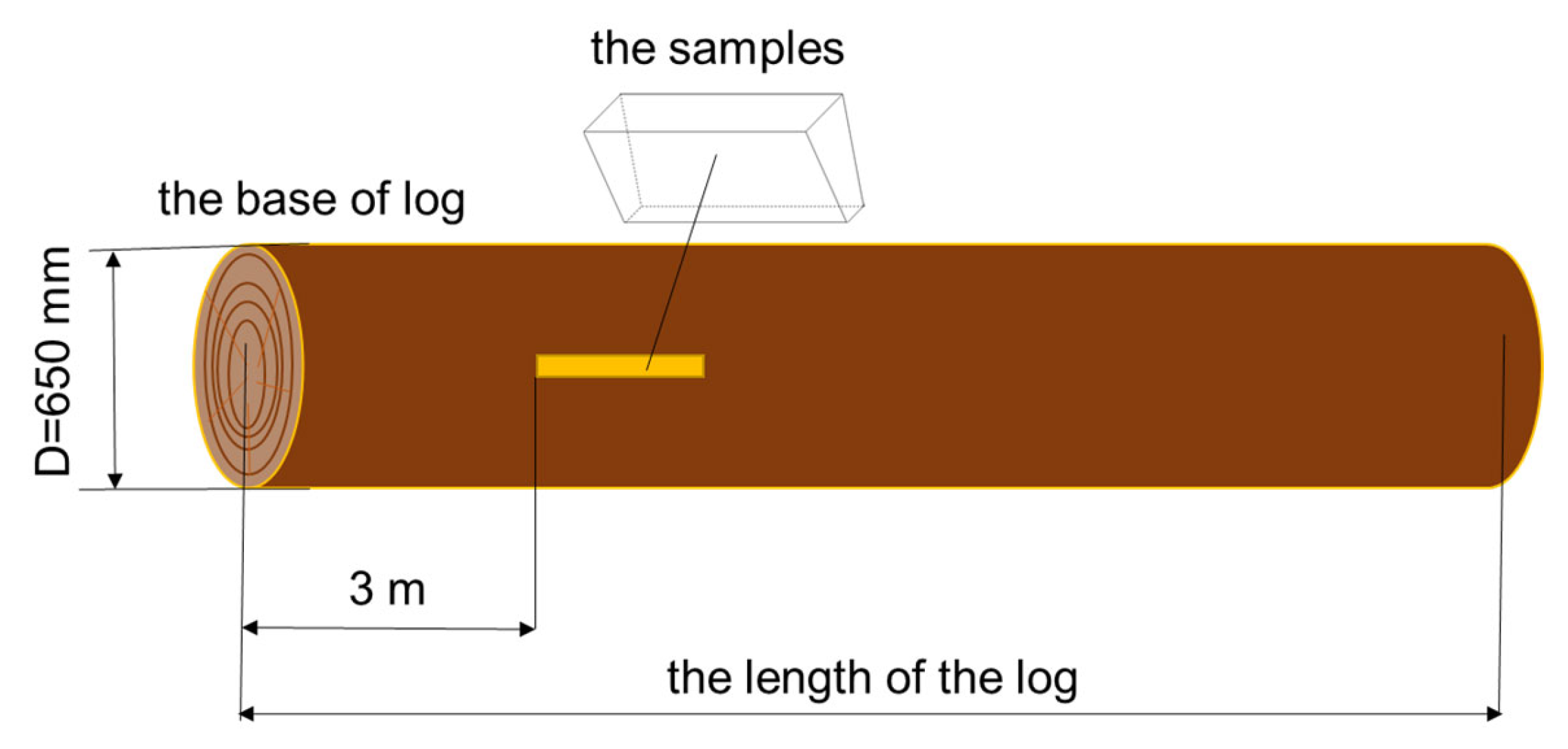

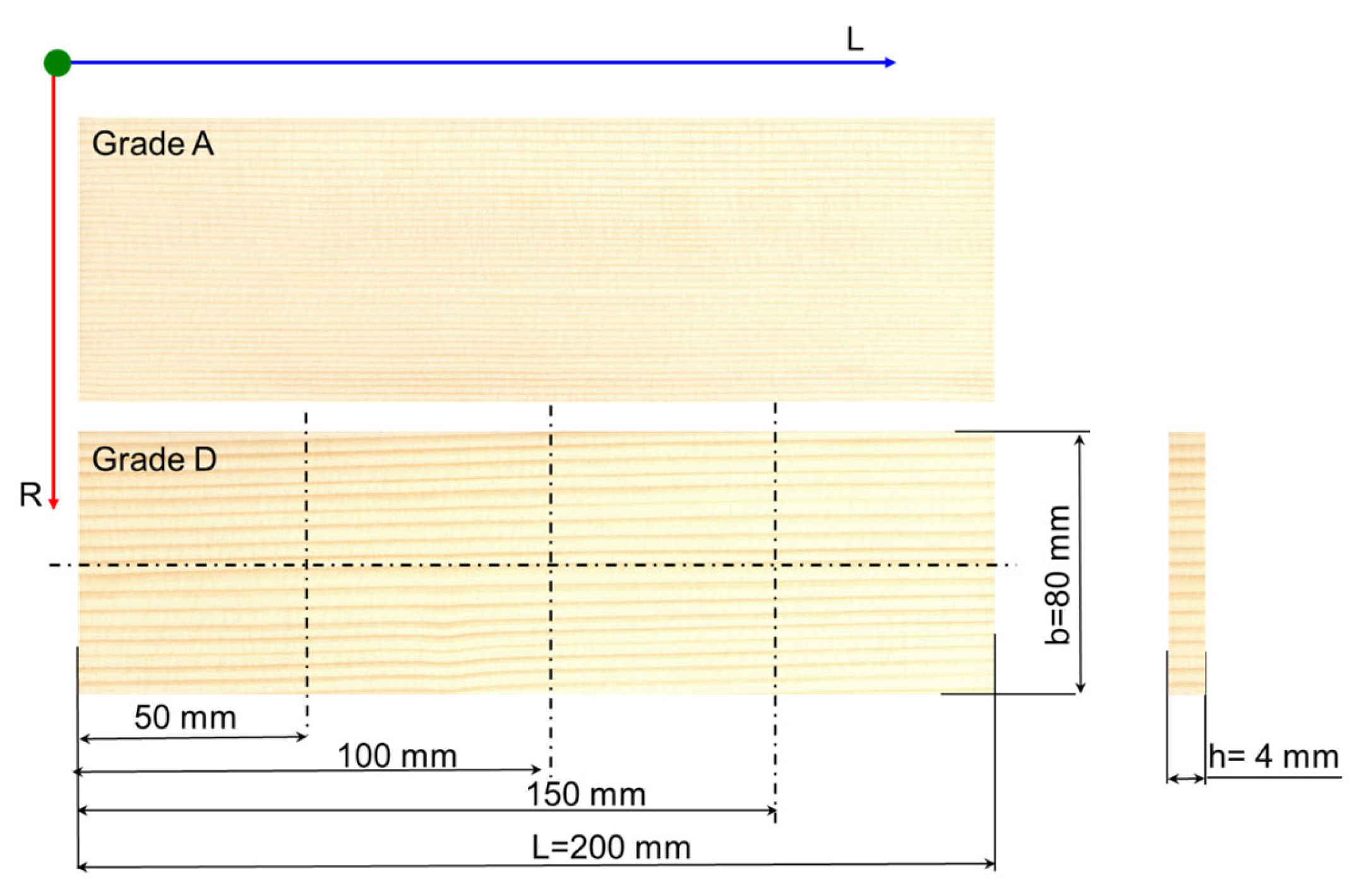

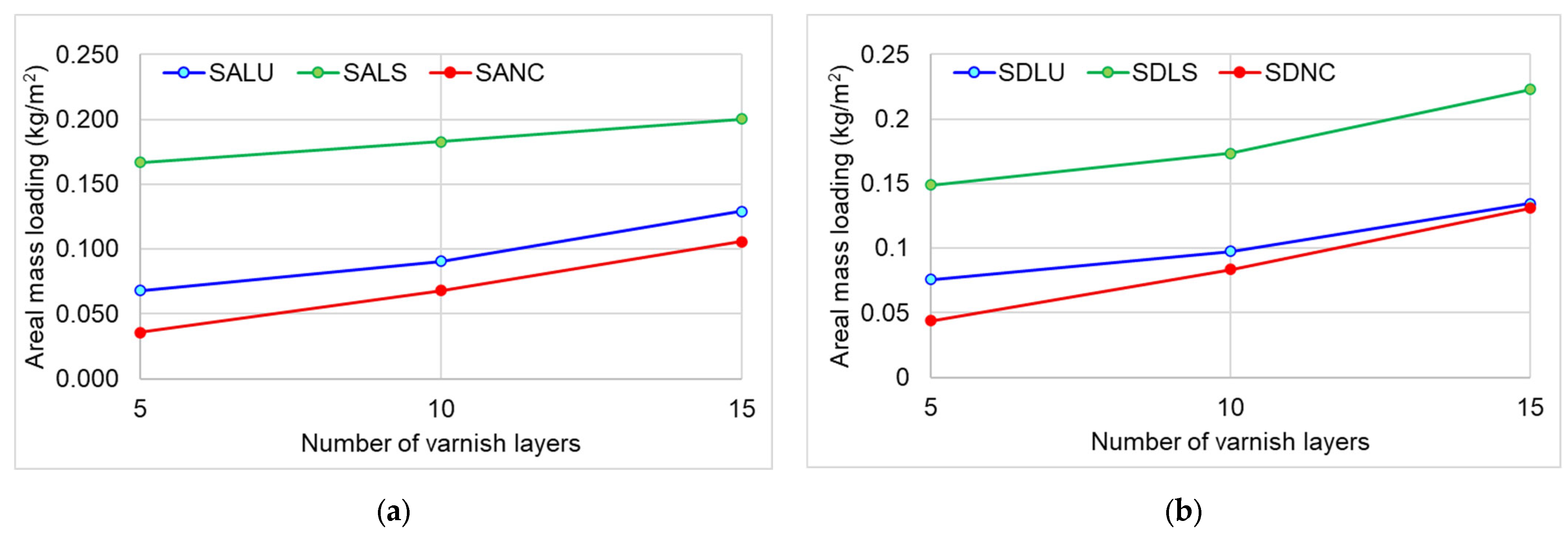

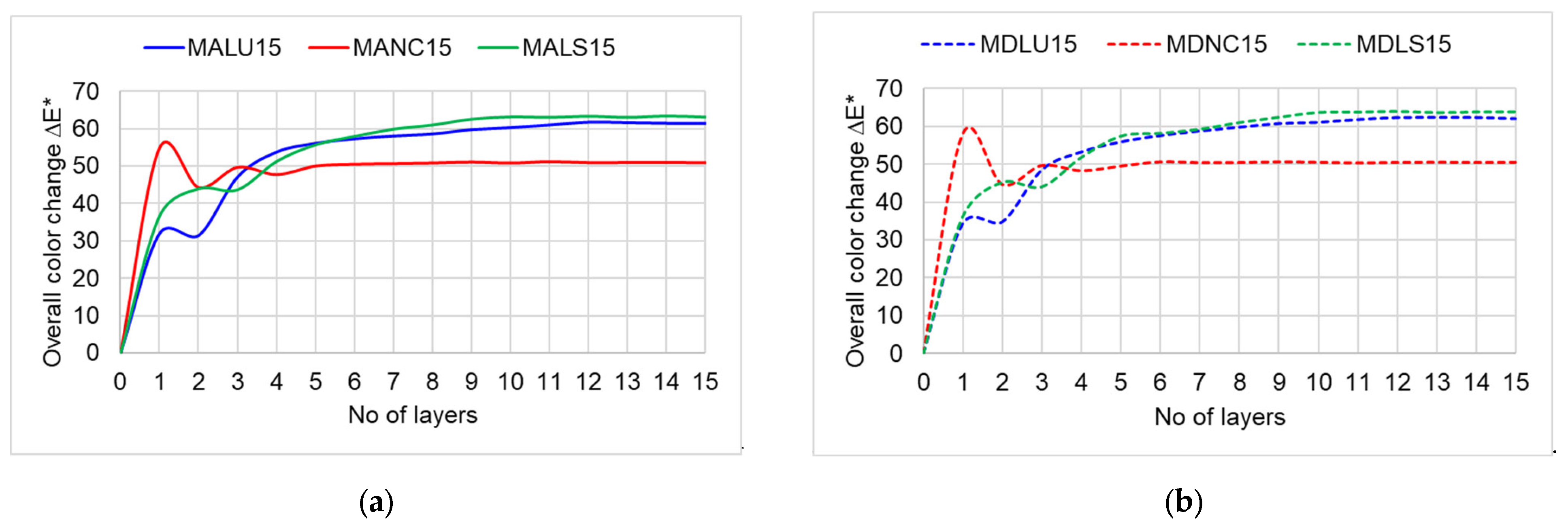
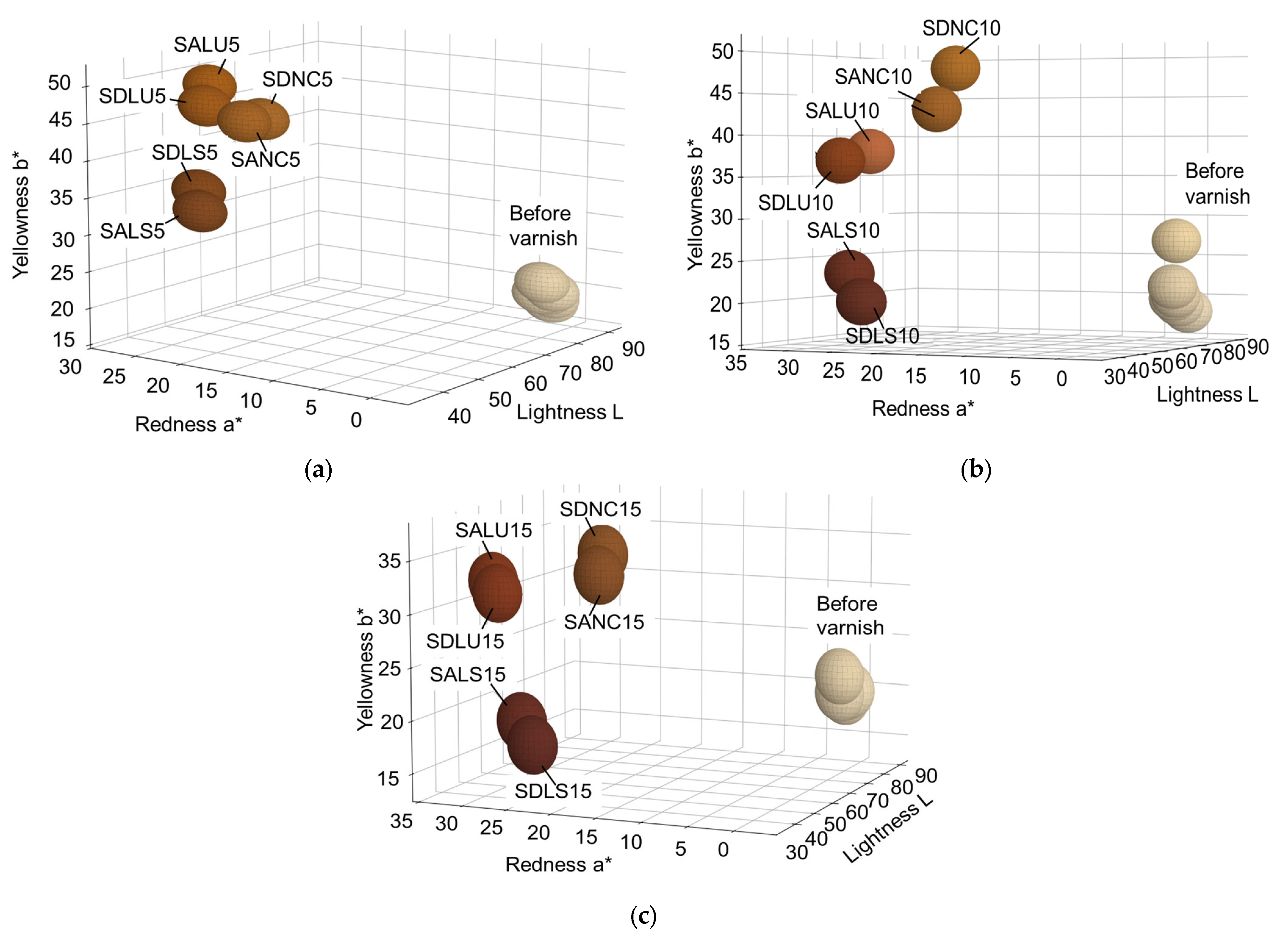

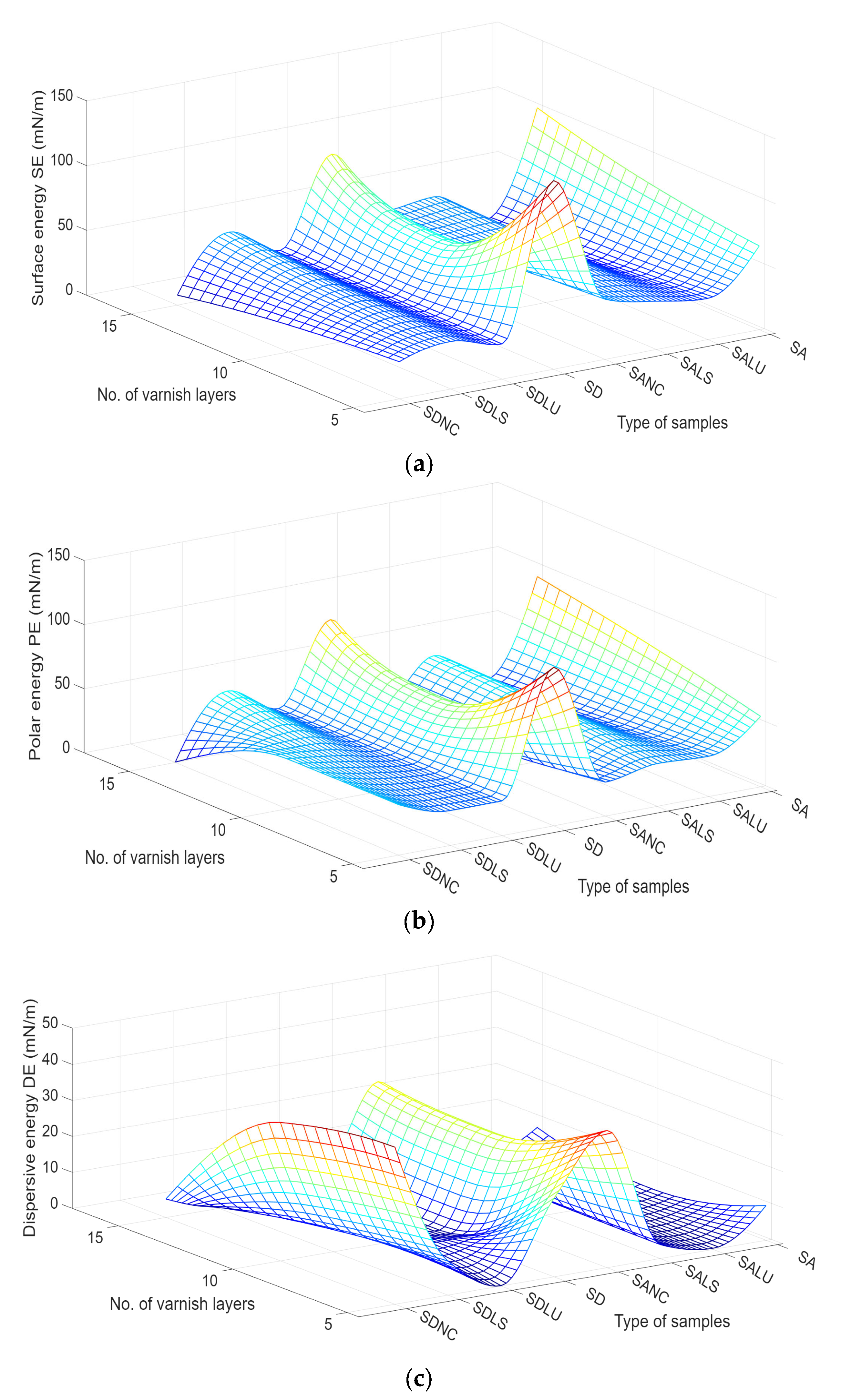
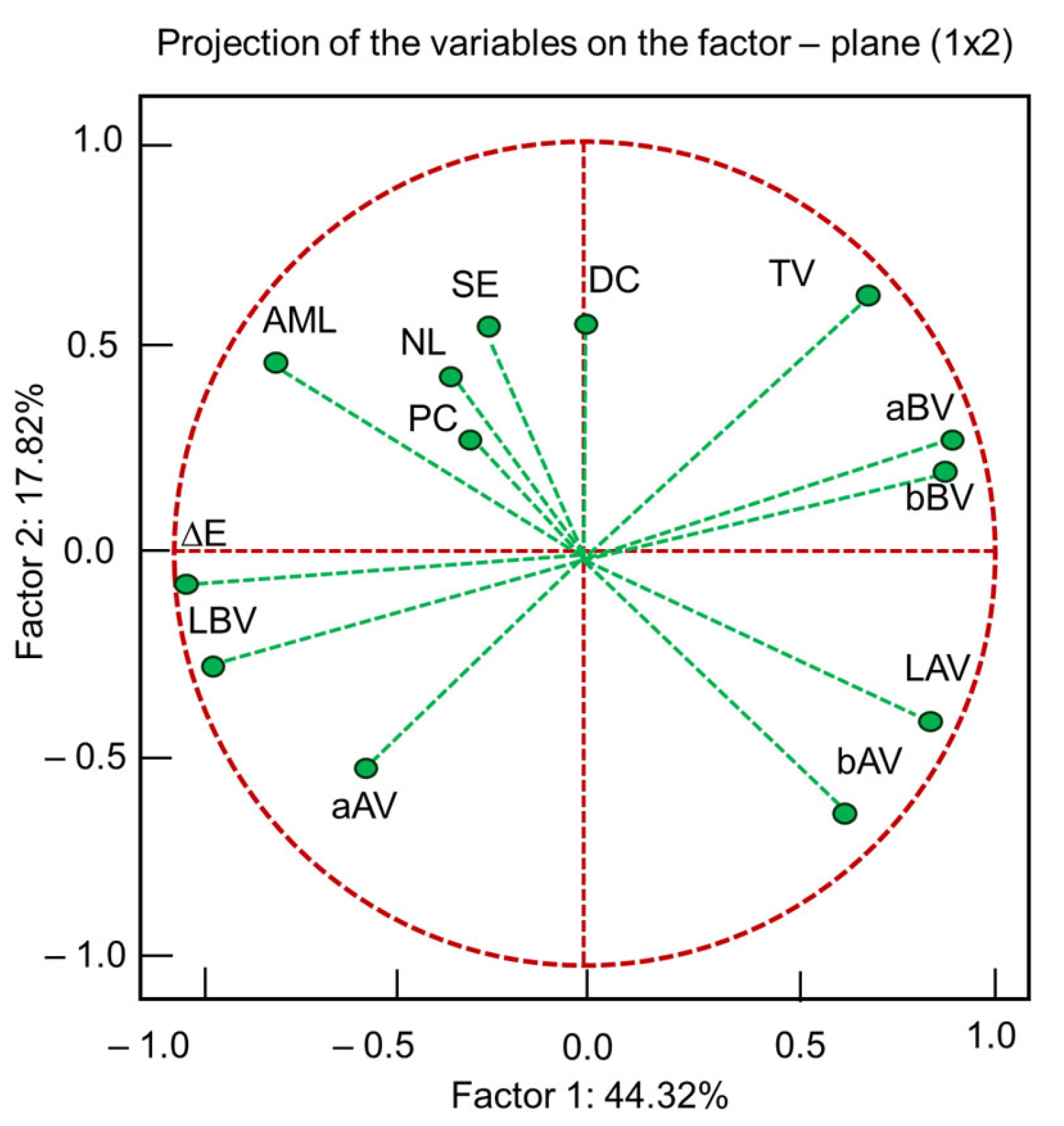


| Type of Material (Code) | Trade Name | Producer | Website |
|---|---|---|---|
| Varnishes | |||
| Oil-based varnish (LU) | Joha Oil Varnish Standard | Hammerl GmbH & Co. KG | https://www.hammerl.com/en/varnishes.html (accessed on 27 July 2025) |
| Alcohol varnish (LS) | Joha Spirit varnish standard | Hammerl GmbH & Co. KG | https://www.hammerl.com/en/varnishes.html (accessed on 27 July 2025) |
| Nitrocellulose varnish (NC) | |||
| Coloring materials | |||
| Color extracts for varnishes (CEV) | Joha red (2903) Joha yellow (2901) Joha brown (2904) | Hammerl GmbH & Co. KG | https://www.hammerl.com/en/varnishes.html (accessed on 27 July 2025) |
| Water stains * (WS) | 169 red brown 125 pure yellow 104 nut brown dark | Hammerl GmbH & Co. KG | https://www.hammerl.com/en/varnishes.html (accessed on 27 July 2025) |
| Kalium dichromate ** (KD) | - | International Laboratory SRL, Cluj Napoca, Romania | |
| Samples | (kg/m2) | (%) |
|---|---|---|
| SALU5 | 0.068 | - |
| SALU10 | 0.090 | 33.052 |
| SALU15 | 0.129 | 42.580 |
| SALS5 | 0.167 | - |
| SALS10 | 0.183 | 9.606 |
| SALS15 | 0.200 | 9.409 |
| SANC5 | 0.036 | - |
| SANC10 | 0.068 | 90.322 |
| SANC15 | 0.106 | 55.205 |
| SDLU5 | 0.076 | - |
| SDLU10 | 0.097 | 28.732 |
| SDLU15 | 0.134 | 37.949 |
| SDLS5 | 0.149 | - |
| SDLS10 | 0.173 | 16.624 |
| SDLS15 | 0.223 | 28.498 |
| SDNC5 | 0.044 | - |
| SDNC10 | 0.084 | 90.844 |
| SDNC15 | 0.131 | 56.573 |
| Samples | Before Varnish | After Varnish | |||||
|---|---|---|---|---|---|---|---|
| L* | a* | b* | L* | a* | b* | ||
| SALU5 | 85.49 (0.86) | 2.06 (0.50) | 19.46 (0.62) | 48.37 (3.44) | 24.03 (1.76) | 49.13 (2.39) | 52.34 |
| SALU10 | 86.13 (0.17) | 1.74 (0.22) | 20.02 (0.64) | 39.43 (4.62) | 29.43(0.54) | 38.06 (7.35) | 46.19 |
| SALU15 | 87.12 (0.25) | 1.29 (0.17) | 19.54 (0.47) | 35.86 (2.02) | 30.38 (0.47) | 32.39 (3.05) | 60.32 |
| SALS5 | 86.40 (0.42) | 1.58 (0.07) | 19.33 (0.40) | 38.42 (1.21) | 21.08 (3.76) | 33.79 (2.23) | 53.77 |
| SALS10 | 86.11 (1.14) | 1.96 (0.46) | 19.61 (0.69) | 31.35 (2.63) | 25.43 (0.90) | 23.55 (4.33) | 59.90 |
| SALS15 | 85.99 (0.22) | 1.83 (0.10) | 19.51 (0.25) | 29.02 (0.41) | 25.44 (0.59) | 19.92 (1.24) | 61.68 |
| SANC5 | 85.01 (0.62) | 1.64 (0.36) | 21.14 (0.50) | 49.78 (0.85) | 20.80 (0.20) | 44.57 (1.42) | 46.45 |
| SANC10 | 84.72 (1.11) | 1.77 (0.97) | 21.15 (0.91) | 49.92 (1.41) | 20.54 (0.40) | 43.20 (1.43) | 45.27 |
| SANC15 | 84.94 (0.30) | 1.64 (0.27) | 21.27 (0.76) | 41.85 (1.08) | 19.80 (0.53) | 33.13 (1.29) | 48.24 |
| SDLU5 | 87.38 (0.63) | 1.38 (0.27) | 18.70 (0.90) | 46.74 (3.66) | 23.92 (1.40) | 46.57 (5.39) | 54.19 |
| SDLU10 | 86.34 (1.16) | 1.68 (0.33) | 18.96 (1.59) | 38.75 (3.77) | 28.66 (3.43) | 36.97 (6.72) | 55.63 |
| SDLU15 | 87.16 (0.28) | 1.40 (0.15) | 19.06 (1.10) | 35.44 (4.71) | 29.80 (3.04) | 31.31 (7.69) | 60.26 |
| SDLS5 | 87.22 (0.29) | 1.48 (0.25) | 18.08 (1.27) | 39.08 (3.20) | 21.47 (3.16) | 36.40 (3.26) | 55.26 |
| SDLS10 | 87.06 (0.31) | 1.54 (0.13) | 18.93 (0.69) | 29.44 (2.55) | 23.58 (1.39) | 20.24 (5.35) | 61.71 |
| SDLS15 | 87.05 (0.28) | 1.41 (0.15) | 19.07 (0.26) | 27.74 (1.23) | 23.93 (2.03) | 17.92 (3.26) | 63.45 |
| SDNC5 | 86.68 (0.42) | 1.15 (0.65) | 19.79 (1.27) | 51.80 (1.22) | 19.63 (0.58) | 44.83 (3.34) | 46.75 |
| SDNC10 | 87.85 (1.24) | 0.71 (0.54) | 18.10 (0.55) | 54.61 (2.83) | 19.61 (0.77) | 48.22 (1.43) | 48.68 |
| SDNC15 | 87.24 (0.62) | 0.86 (0.32) | 19.76 (0.90) | 43.36 (1.03) | 19.71 (0.68) | 35.02 (1.88) | 50.14 |
| Samples | Before Varnish | After Varnish | ||||
|---|---|---|---|---|---|---|
| Red | Green | Blue | Red | Green | Blue | |
| SALU5 | 232 | 211 | 177 | 169 | 97 | 27 |
| SALU10 | 234 | 213 | 178 | 148 | 71 | 30 |
| SALU15 | 235 | 216 | 181 | 138 | 62 | 33 |
| SALS5 | 234 | 214 | 180 | 134 | 76 | 35 |
| SALS10 | 234 | 213 | 179 | 118 | 56 | 38 |
| SALS15 | 233 | 213 | 178 | 111 | 51 | 34 |
| SANC5 | 231 | 210 | 173 | 168 | 103 | 40 |
| SANC10 | 230 | 209 | 172 | 168 | 104 | 44 |
| SANC15 | 231 | 210 | 172 | 142 | 85 | 44 |
| SDLU5 | 236 | 217 | 184 | 164 | 93 | 29 |
| SDLU10 | 233 | 214 | 180 | 145 | 70 | 31 |
| SDLU15 | 235 | 216 | 182 | 136 | 61 | 34 |
| SDLS5 | 235 | 216 | 184 | 137 | 77 | 32 |
| SDLS10 | 235 | 216 | 182 | 110 | 53 | 39 |
| SDLS15 | 235 | 216 | 182 | 105 | 49 | 39 |
| SDNC5 | 234 | 215 | 180 | 172 | 109 | 45 |
| SDNC10 | 235 | 219 | 186 | 181 | 116 | 44 |
| SDNC15 | 235 | 217 | 181 | 146 | 89 | 44 |
| Sample Properties | Mean | Standard Deviation | Normality * | The Significance of Differences Between | ||
|---|---|---|---|---|---|---|
| SS ** | TV *** | NL *** | ||||
| AML | 0.126 | 0.05 | NO | 0.6800 | <0.001 | <0.001 |
| LBF | 84.903 | 2.63 | NO | 0.0020 | - | |
| aBF | 2.492 | 1.42 | NO | 0.0300 | - | |
| bBV | 21.151 | 3.01 | NO | 0.0010 | ||
| LAV | 40.039 | 8.11 | NO | 0.5000 | <0.001 | <0.001 |
| aAV | 23.946 | 3.93 | NO | 0.3700 | <0.001 | <0.001 |
| bAV | 34.691 | 9.90 | NO | 0.6500 | <0.001 | <0.001 |
| DE | 52.752 | 9.04 | NO | 0.1900 | <0.001 | <0.001 |
| SE | 51.263 | 39.38 | NO | 0.6800 | <0.001 | 0.87 |
| PC | 35.075 | 35.96 | NO | 0.0200 | 0.28 | 0.13 |
| DC | 16.234 | 22.63 | NO | 0.1300 | <0.001 | 0.4 |
Disclaimer/Publisher’s Note: The statements, opinions and data contained in all publications are solely those of the individual author(s) and contributor(s) and not of MDPI and/or the editor(s). MDPI and/or the editor(s) disclaim responsibility for any injury to people or property resulting from any ideas, methods, instructions or products referred to in the content. |
© 2025 by the authors. Licensee MDPI, Basel, Switzerland. This article is an open access article distributed under the terms and conditions of the Creative Commons Attribution (CC BY) license (https://creativecommons.org/licenses/by/4.0/).
Share and Cite
Stanciu, M.D.; Timar, M.C.; Mihalcica, M.; Cosnita, M.; Dinulică, F. Comparisons of the Effects of Polymer and Alcohol Varnishes on Norway Spruce Wood Surface Modifications. Polymers 2025, 17, 2131. https://doi.org/10.3390/polym17152131
Stanciu MD, Timar MC, Mihalcica M, Cosnita M, Dinulică F. Comparisons of the Effects of Polymer and Alcohol Varnishes on Norway Spruce Wood Surface Modifications. Polymers. 2025; 17(15):2131. https://doi.org/10.3390/polym17152131
Chicago/Turabian StyleStanciu, Mariana Domnica, Maria Cristina Timar, Mircea Mihalcica, Mihaela Cosnita, and Florin Dinulică. 2025. "Comparisons of the Effects of Polymer and Alcohol Varnishes on Norway Spruce Wood Surface Modifications" Polymers 17, no. 15: 2131. https://doi.org/10.3390/polym17152131
APA StyleStanciu, M. D., Timar, M. C., Mihalcica, M., Cosnita, M., & Dinulică, F. (2025). Comparisons of the Effects of Polymer and Alcohol Varnishes on Norway Spruce Wood Surface Modifications. Polymers, 17(15), 2131. https://doi.org/10.3390/polym17152131









